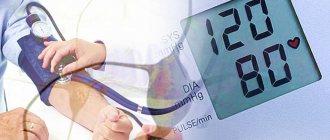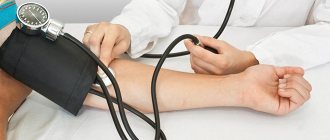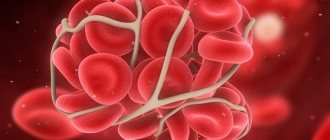Home / Heart
Back
Published: 01/31/2020
0
1
- 1 Girls, blood pressure 100 to 60
- 2 High blood pressure during pregnancy
- 3 How to normalize blood pressure?
- 4 Reasons for the increase
- 5 Reasons for the downgrade
- 6 Danger and risks
- 7 Symptoms of hypotension
- 8 Is low blood pressure dangerous?
- 9 Is blood pressure dangerous: 100 to 60, what to do
For whom are blood pressure readings of 90 to 60 normal?
Blood pressure in the indicated values can be considered normal only for three groups of the population. These are children under 7 years of age, pregnant women and people hereditarily predisposed to hypotension.
For everyone else, the drop in blood pressure is either physiological (if it happened once) or pathological (if it occurs on a regular basis).
In the latter case, hypotension can be either primary (i.e., an independent pathology) or secondary (it can be a consequence of a number of diseases, in other words, it is a symptom of them).
Causes of a one-time drop in blood pressure
Blood pressure is not at the same level all the time. It changes every second, that is, it is a dynamic indicator.
The degree of danger of hypotension should be assessed based on the condition of the blood vessels, tonometer numbers and the frequency of development of the pathological process.
In most cases, we have to talk about a one-time change in blood pressure (the so-called crisis). Why is this phenomenon observed?
- Orthostatic changes. In other words, orthostatic hypotension. It develops when there is a sudden change in the position of the patient’s body in space. For example, if a person suddenly gets up from a lying or sitting position, while he has been at rest for a long time. This provokes a violation of blood circulation in the riverbed, and at all levels. Characteristic signs are observed: darkening of the eyes, weakness, loss of coordination, ringing in the ears. A short-term fainting state may occur.
- Traumatic brain injury. The one that just happened is common. Impaired blood circulation is associated with brain damage. This is possible with a concussion of cerebral structures (for example).
- The reason for the pressure of 90 to 60 may also lie in an allergic reaction. Allergy is accompanied by the mobilization of all the forces of the body to fight an imaginary foreign object. The extreme degree of an allergic reaction is anaphylactic shock, in which the pressure reaches critically low levels. Urgent and qualified medical assistance is required. Better in a hospital setting.
- Dehydration. In other words, there is a lack of fluid circulation in the body. It happens quite often, especially in the hot season or in special regions of the globe (tropics, subtropics). By reducing pressure, the body seeks to minimize fluid loss. This is a completely physiological, although dangerous phenomenon. Replenishment of water in the body is required.
- Stress, especially intense. They develop in almost everyone, but do not always end in attacks of hypotension (low blood pressure). We are talking about people of a special type, on the one hand, but on the other hand, we have to talk about some features of the body of a particular person. It is necessary to understand each case separately.
- Intense physical activity, for example, when playing sports or performing professional duties. This is a twofold process, on the one hand, the pressure at the first moment increases in order to provide the tissues with the necessary amount of nutrients and oxygen. On the other hand, it then drops, especially after the end of physical activity. A significant difference is dangerous and can cause a heart attack or stroke. You need to carefully monitor your well-being and not overindulge in activity if you have problems with the cardiovascular system.
A blood pressure of 90 over 60 is dangerous, but not always. You need to look at the individual characteristics of the body and the reason that caused the jump in blood pressure.
Possible complications in pregnant women
Pregnant women with arterial hypotension, as with other vascular disorders, often (in 25% of cases) develop gestosis (the appearance of edema, protein in the urine, increased blood pressure). In this condition, in patients with hypotension, blood pressure may not exceed normal values (120/80 mmHg), but it will be 30% higher than the initial one, and this is considered pathology. As already mentioned, such patients are more likely than healthy women to develop early toxicosis of pregnancy with arterial hypotension.
The main complications of pregnancy with arterial hypotension include its spontaneous termination. With this disease, it is observed at various stages of pregnancy 3-5 times more often than in healthy women. The opposite effect is also noted: in women who remain in bed for a long time due to the threat of miscarriage, blood pressure steadily decreases, apparently due to muscle inactivity.
Arterial hypotension contributes to intrauterine growth retardation due to reduced uteroplacental blood flow.
In patients with arterial hypotension, complications of labor are often observed; they are mainly associated with impaired contractility of the uterus. This creates difficulties in the management of childbirth and promotes the expanded use of surgical methods of delivery (caesarean section) in order to provide assistance to the suffering fetus. Childbirth is often accompanied by bleeding.
Reasons for regular low blood pressure
In this case, the reasons are much more serious. You need to understand the hospital conditions or, at a minimum, undergo consultations with different specialists.
What are the factors that reduce blood pressure (secondary hypotension) on a regular basis?
- Stomach ulcer, especially one that lasts for a long time and is not treated. We are talking about bleeding of a constant nature. The more intense the outpouring of hematological fluid, the more pronounced the decrease in blood pressure. In most cases, this process is caused by a decrease in the amount of blood in the bloodstream.
- Pregnancy. The gestation period is difficult for the fairer sex in itself: there is toxicosis, difficulties with movement, and lipid metabolism disorders. The picture is complemented by a constant decrease in the level of blood pressure in a pregnant woman.
- Acute heart attack, other changes in cardiac function. After a heart attack, the functioning of the organ is disrupted, a significant decrease in blood pressure occurs, so indicators of 90 to 60 are a typical picture.
- Coronary heart disease, congestive heart failure. Provokes disruption of the heart and the entire circulatory system as a whole. Requires urgent medical correction, preferably in a specialized cardiology hospital.
- Diseases of the hypothalamic-pituitary system. This is a whole layer of pathological processes, caused in most cases by disorders in the chiasmal-sellar region. Usually we are talking about injuries or tumors (adenomas and others). It is not so easy to identify such a cause of low blood pressure; an MRI is necessary.
- Hormonal imbalances resulting from insufficient production of specific thyroid substances. This is the so-called hypothyroidism. With hyperthyroidism, when there is an excess of hormones, this almost never happens. The disease can be suspected by specific accompanying symptoms and phenomena.
- Impaired cortisol production. As a result of diseases and operations. Cortisol is responsible for part of the regulation of blood pressure levels. This phenomenon is called Addison's disease and can be accompanied by tonometer readings of 90 to 60 and a pulse of 90-95.
- Abuse of antihypertensive drugs. Primarily calcium channel blockers, ACE inhibitors, diuretics. They cause a drop in blood pressure at a systematic level. There should be no overdose. Tricyclic antidepressants, including Doxepin and Imipramine, have a similar effect on blood pressure. Drugs for the treatment of erectile dysfunction based on sildenafil and tadalafil also lower blood pressure, especially when used together with nitroglycerin.
- Poisoning of various etiologies: alcohol, drugs, bacterial toxins during infectious processes. Blood redistribution occurs as a result of capillary expansion. This is dangerous because it can cause a sharp drop in blood pressure.
- Dystonia, stroke, other cerebrovascular accidents of a transient and persistent nature. Urgent medical attention is required.
- Osteochondrosis of the cervical spine. It can also cause pressure of 90 to 60 or even lower. Causes vertebrobasilar insufficiency with cerebrovascular accident.
How to measure your blood pressure yourself
Blood pressure is measured using a device called a tonometer. You can also take measurements with a mechanical tonometer, although today they are considered obsolete. You can buy an electronic device at any pharmacy: this medical gadget will serve you for a long time, and not only during pregnancy will you need to measure your blood pressure. Read the instructions in detail.
To get accurate data you need:
- Try to take measurements at the same time;
- Do not drink coffee (do this at least an hour before the procedure);
- Do not smoke - although every woman knows about the harmful effects of nicotine on the development of the fetus in the womb, many pregnant women do not give up this habit;
- Before the measurement you need to calm down, don’t worry, you can lie down for a few minutes;
- If your bladder is full, go to the toilet first, and only then take a measurement;
- Do not talk, move or twist during the measurement; your feet should be parallel to each other on the floor (do not cross them);
- After 7 minutes (8-10 is possible), take a new measurement - it should be equivalent to the previous one, a small run-up is acceptable (if it is large, most likely you are doing something wrong);
- Take the measurement while sitting, with your hand resting on the table.
If you take any prescribed medications, remember that some of them affect your blood pressure, so do not take the measurement immediately, but a couple of hours after taking it.
What pressure should a pregnant woman have, see the table above.
Blood pressure 90/60 during pregnancy
As already mentioned, pregnancy is a complex process. As is clear, such pressure (85 to 60 or 55) does not require therapy.
However, there is little pleasant in gestation: the hormone progesterone disrupts blood circulation, the woman experiences secondary anemia and constant tachycardia. However, this is quite normal.
Such hypotension is called physiological and does not require correction with medications except in exceptional cases. Consultation with a gynecologist is recommended.
Are similar numbers on a tonometer with a pulse of 60-80 dangerous?
There are several ways to answer. On the one hand, a pulse of 60-75-80 is not yet bradycardia, that is, a decrease in the number of heartbeats.
On the other hand, you need to look at the reason that brought such a difficult process to life.
If it is vegetative-vascular dystonia, we are talking about one thing. But if a patient has a heart attack, it's a completely different matter. Here the number of heartbeats per minute does not play such a role.
With a pulse of 90-100?
This is already an increased number of heartbeats. A pressure of 90 over 60 and a pulse of 100 beats per minute or higher is pronounced tachycardia, which indicates the following conditions:
- A marked decrease in body temperature (in the language of a common person - loss of strength).
- Significant blood loss. Usually as a result of injury or illness.
- Avitaminosis. Lack of vitamin B-12 and folic acid. Hypovitaminosis can also manifest itself in a similar way.
- Shock states.
- Acute infectious and inflammatory processes of various nature. Also just inflammatory processes of non-infectious etiology (hepatitis, pancreatitis, gastritis).
- Pregnancy.
- Anemia (iron deficiency primarily).
- Various lesions of the heart and circulatory system. Here are just a few possible reasons. In fact, there are many more of them.
First aid for low blood pressure
There is very little you can do on your own. Qualified medical assistance is required.
If the pressure drops to 90 over 60, this is a low, but not critical indicator, but you should not hesitate to visit a doctor.
You can help yourself or a nearby patient in the following ways:
- Take a lying position. Move as little as possible, especially not get up, since orthostatic hypotension is possible in addition to the main process.
- Loosen all things putting pressure on the neck: jewelry, shirts, ties, bow ties, etc. Because adequate blood flow is necessary.
- Place a damp cloth on the patient's head: a simple handkerchief will do.
- Provide fresh air flow into the room. You need to do this first.
- Give the patient something to eat that is high in table salt.
- It would be nice to take a Citramon tablet or regular aspirin. They will help to quickly increase blood pressure, and will do it very gently.
- Drink tea or strong coffee (if your pulse is no more than 80 beats per minute).
Symptoms requiring an ambulance call
If hypotension occurs against the background of an increased number of heartbeats per minute (pulse within 90-110), you need to call an ambulance. This is already dangerous.
The main symptoms include the following:
- Headache and dizziness. The first develops due to stenosis (narrowing) of arteries that are well innervated. The second is as a result of impaired circulation of the cerebellum. Both are dangerous.
- Darkening in the eyes, weakness, drowsiness. All three symptoms develop as a result of decreased blood flow to the brain tissue. In the long term, dementia praecox may occur.
- Shortness of breath, chest pain, nausea, vomiting. We may be talking about a pre-infarction state.
Preeclampsia: blood pressure is rising, the threat is great
Blood pressure control, as you understand, is extremely important. If the pressure is high, then due to vascular spasm the functioning of the patient’s main internal organs is disrupted - the kidneys, liver, brain, lungs and even the retina of the eye are affected. The child does not receive enough oxygen and nutrients, and this is a direct threat to delay his development. The amount of amniotic fluid in the uterus may decrease. Blood flow in the umbilical artery may slow down. In severe cases, unfortunately, emergency delivery cannot be avoided.
Many pregnant women complain: they forced them to give urine again, and they also tell them to measure their blood pressure every day and write down the result on a piece of paper. But this is not unnecessary trouble! Frequent urine tests and regular blood pressure measurements are aimed specifically at preventing preeclampsia.
| What does high blood pressure mean during pregnancy? | ||
| Chronic hypertension | Gestational hypertension | Preeclampsia |
| Blood pressure above 140/90, detected before pregnancy or the beginning of the 20th week of gestation | Increased blood pressure from 140/90, there was no high blood pressure before pregnancy, no protein was detected in the urine, gestation period less than 20 weeks | Increased blood pressure, where SBP is above 140 and/or DBP is above 90 (pressure measured twice at least four hours apart), tests reveal proteinuria |
Preeclampsia without protein in urine
Sometimes the diagnosis of “preeclampsia” is made even if there is no protein in the urine, but in this case the doctor notices another symptom.
In this list:
- Decreased platelet levels;
- Increased creatinine;
- Increase in AST and ALT at least twofold;
- Development of pulmonary edema;
- Cerebral or visual symptoms - from severe headaches to blurred vision, the appearance of “floaters” before the eyes.
The diagnosis of “preeclampsia” can only be made when your blood pressure was normal before pregnancy, and only after the 20th week did complications begin in the form of increased blood pressure and other symptoms associated with the pathology.
Doctors cannot yet give a definite answer as to why this disease occurs in principle. Most scientists agree that this is a vascular anomaly (we are talking about the vessels that are located between the uterus and the placenta). And this anomaly is just the beginning of a chain of negative consequences.
Preeclampsia has its own risk factors; it has been proven that the pathology is more often diagnosed during the first pregnancy. Women with diabetes, obesity, under the age of 20 or over 35 are prone to it. There are greater risks in patients with multiple pregnancies, as well as in those who encountered such a pathology during the first gestation. Heredity can also be a reason.
Diagnosis of preeclampsia and possible complications
Normal blood pressure in a pregnant woman in the third trimester most likely indicates that a threat such as preclampsia has passed you by. But in order to convincingly say that there are no pathologies, early diagnosis is needed - modern pregnancy management provides for this point. Diagnosis includes frequent urine tests, which allow timely detection of protein in urine, as well as regular blood pressure measurements.
These studies seem like a routine to many pregnant women: they argue about the uselessness of these studies - in the West so often expectant mothers are not bothered. But it is not always worthwhile to unconditionally accept Western trends, especially in matters of maintaining a healthy pregnancy. The fact is that preeclampsia, and its possible development - eclampsia, are one of the key causes of maternal and infant mortality. And this applies not so much and only to third world countries, but to the most developed countries.
Why is preeclampsia dangerous?
- The development of eclampsia itself. This is a serious condition with seizures, pulmonary edema, possible cerebral hemorrhage and even coma.
- Placental abruption, which does not allow prolongation of pregnancy and is a direct threat to the life of the mother and fetus.
- Heavy bleeding.
- Development of stroke and thromboembolism.
- Delayed development of the baby.
- Low water.
- Premature birth, which jeopardizes the normal development of the child, and often life.
That is why diagnosis, screening and, of course, early prevention of preeclampsia are so important.
How to Avoid Preeclampsia
There are women who are at greater risk than others of seeing high values on the tonometer during pregnancy, and along with them other signs of pathology.
You may be in this risk category if you match at least one of the following:
- Multiple pregnancy;
- Chronic kidney disease;
- Diabetes mellitus (any type);
- Hypertension;
- Autoimmune diseases;
- Previous pregnancy with preeclampsia.
What should women do with such aggravating circumstances? Firstly, don’t worry, but be glad that you saw the risk in time and this will give you the opportunity to seek help from doctors as early as possible. Secondly, you may have to register with a special person, and doctors will pay a little more attention to your pregnancy.
Today, the following tactics for preventing the disease in relation to the above-mentioned women are common: taking low doses of aspirin, starting from the second trimester of pregnancy. Aspirin is the only medication with proven effectiveness against this gestational illness. But you are not the one who takes Aspirin without permission, but the doctor who prescribes it for you if he sees the need.
Is preeclampsia treatable?
The only effective treatment for preeclampsia and eclampsia is childbirth. Since the disease is triggered by the pregnancy itself, when it ends, the disease will also end. This is the rub, because dangerous pathology occurs most often in the second trimester, or the beginning of the third, when it is too early to think about childbirth.
How to urgently deliver a patient, and how to do this is the responsibility of doctors. There are no general guidelines; all cases are individual. In any case, doctors will prolong the pregnancy as long as this is possible in principle. The duration of pregnancy, the condition of the mother, the condition of the fetus, and prognosis are assessed. At a consultation of doctors, it is decided when to give birth to the patient and how. If the pregnancy is full-term (that is, the gestational age has reached 37 weeks), you can give birth.
If the period is not yet approaching 37 weeks, preeclampsia is mild or moderate, if there are no signs of damage to target organs (and these include headaches, visual disturbances, pain in the heart, in the peritoneum, there is shortness of breath and changes in laboratory tests), Doctors will resort to wait-and-see tactics. A woman in this condition does not need to take antihypertensive drugs.
How to monitor the condition of a patient with preeclampsia:
- Constant pressure control;
- Monitoring the occurrence of negative symptoms;
- Monitoring blood tests - they look at both the platelet count and kidney tests;
- A daily count of the baby's movements in the womb is carried out;
- Ultrasound control twice a week (with Doppler and biophysical profile of the fetus).
Patients with preeclampsia and a gestational age of less than 34 weeks are advised to administer corticosteroids according to a special regimen (2 doses are administered every other day). This is a means of preventing pulmonary diseases in a child. After 34 weeks, steroids are not administered to the mother (dangerous for the baby’s actively dividing brain cells and may lead to future behavioral and cognitive disorders)!
With severe eclampsia, doctors can no longer pay attention to the gestational age, and the woman has to give birth according to vital indications.
Diagnostics
Identifying the cause of a pathological condition is not an easy task, especially when it comes to hypotension.
Consultation with a cardiology specialist is necessary.
You may also need to consult an endocrinologist, gastroenterologist, or neurologist.
At the initial appointment, the patient is interviewed.
Typical complaints about health and well-being in general are identified, and the doctor records all data in writing for subsequent assessment. A life history is collected.
This is also a very important part of the examination.
The following are objective diagnostic measures:
- Blood pressure measurement. On both hands with a frequency of 10-15 minutes or a little more. Usually no more than 2-3 times.
- Daily monitoring. Required to identify blood pressure dynamics throughout the day. Detects hypotension with great accuracy.
- Electrocardiography to exclude cardiac etiology of the process.
- Encephalogram.
- Hormonal tests (T3, T4, TSH, cortisol). To determine the possible endocrine origin of the pathology.
- MRI diagnostics.
- Stress tests (with physical activity).
Usually this is quite enough. The list can be expanded or narrowed at the discretion of the doctor.
How is hypotension treated?
Treatment of hypotension consists of eliminating the underlying disease, which is identified during the diagnostic process.
In all cases, it is recommended to normalize the diet, drinking regimen, sleep pattern, and physical activity.
It is important to consult a doctor in time. Only he can draw up the correct scheme for correcting the condition, taking into account the characteristics of the patient’s body.
Hypotension with a pressure level of 90 to 55-60 does not pose a great danger, however, it is an alarm bell. You need to see a doctor and look for the cause of the condition.
In clinical practice, blood pressure (BP) readings are considered low: 90 to 60. This pressure does not always have side effects. For some it does not cause concern, for others the condition leads to hypotension. It is because of the difference in clinical manifestations that confusion arises among people far from medicine.
When are such values normal, in what cases are they pathological? What needs to be done to bring the condition back to normal? What can you say when a person's blood pressure is 90 over 60? Is this blood pressure normal? Let's set the record straight by dispelling controversial rumors.
Possible complications in pregnant women
Pregnant women with arterial hypotension, as with other vascular disorders, often (in 25% of cases) develop gestosis (the appearance of edema, protein in the urine, increased blood pressure). In this condition, in patients with hypotension, blood pressure may not exceed normal values (120/80 mmHg), but it will be 30% higher than the initial one, and this is considered pathology. As already mentioned, such patients are more likely than healthy women to develop early toxicosis of pregnancy with arterial hypotension.
The main complications of pregnancy with arterial hypotension include its spontaneous termination. With this disease, it is observed at various stages of pregnancy 3-5 times more often than in healthy women. The opposite effect is also noted: in women who remain in bed for a long time due to the threat of miscarriage, blood pressure steadily decreases, apparently due to muscle inactivity.
Arterial hypotension contributes to intrauterine growth retardation due to reduced uteroplacental blood flow.
In patients with arterial hypotension, complications of labor are often observed; they are mainly associated with impaired contractility of the uterus. This creates difficulties in the management of childbirth and promotes the expanded use of surgical methods of delivery (caesarean section) in order to provide assistance to the suffering fetus. Childbirth is often accompanied by bleeding.
Why does a person have low blood pressure?
It must be taken into account that the value of blood pressure is individual for each individual organism. The generally accepted medical norm is 100–130 to 60–89. Why is low blood pressure 90 over 60 normal for some, but hypotonic for others? For example, for some young females such indicators are the physiological norm. Others, when blood pressure drops to these levels, experience unpleasant symptoms associated with hypotension. There are several things that can trigger this condition.
Among them:
- sedentary lifestyle;
- taking certain medications;
- work in hazardous production;
- change in diet;
- procedures that cause vasodilation - sauna, Russian bath, body wraps, etc.
In the first case, low activity may be associated with a disease that has forced the person to minimize movements.
Many people have a question - if the low pressure is 90 over 60, what should you do? If we talk about medications, the following can reduce blood pressure:
- cardiac drugs;
- pain reliever;
- antispasmodics and sedatives.
Third trimester and increased blood pressure
At this time, it is most likely that the blood pressure in the vessels will become higher. But at the time of birth, this indicator should approach prenatal values. At 32-38 weeks, a woman’s cardiovascular system experiences the greatest load - the heart rate quickens, blood output increases by 40, or even 50%, and the pulse increases.
Why are both doctors and pregnant women themselves so afraid of high blood pressure values? Associated with them is the concept of “gestosis,” a pathology that can only affect pregnant women. One of the signs of this dangerous condition is an increase in blood pressure. This is a truly insidious disease; it entails changes in the functioning of various organs - the circulatory and cardiovascular systems are especially affected.
Preeclampsia is a threat to a healthy pregnancy:
- Its presence can be indicated by swelling in the legs and hands - they arise due to the smallest vascular openings that appear as a result of the production of special substances by the placenta;
- Plasma protein and liquid enter these small holes, and although the edema itself does not pose a threat to the mother, placental edema will lead to a serious lack of oxygen for the baby.
But even if gestosis is not detected, and the pressure is higher than normal, this can still lead to vascular changes. They will definitely affect the child; there is a high risk of developing fetoplacental insufficiency. With maternal hypertension, the fetus develops hypoxia and the baby’s development slows down. The child may be born with pathologies and may be premature. Neurological disorders cannot be ruled out due to the same high blood pressure in the mother during pregnancy.
Is this condition dangerous?
Of course, if you are not one of the people for whom such indicators are normal, you should look for the reason. After all, over time, health can deteriorate. Treatment boils down to eliminating the underlying disease that causes low blood pressure.
A sharp drop in values is considered the most dangerous condition. Even if this happens when the increased indicators decrease. As a rule, this happens due to diseases:
- anaphylactic shock;
- blood loss;
- heart failure, etc.
Such conditions can cause impaired consciousness, kidney problems, and even coma.
What to do?
If low pressure is 90 to 60, what should I do? First of all, don't panic. This is not a critical indicator. With the help of an examination, rule out diseases leading to this result.
- You will be prescribed the necessary tests, including a general blood and urine test.
- They will also take blood to determine electrolytes.
- They will do an ECG, ECHO-CG, chest x-ray, ultrasound of the abdominal cavity and blood vessels of the legs.
Next, the doctor will prescribe the necessary treatment. If there are no serious reasons for concern, lifestyle adjustments will help.
Hypertension and gestational diabetes mellitus
This is a separate topic, but it would also be wrong not to touch on it in the material on blood pressure during pregnancy. Gestational diabetes mellitus is a pathology that occurs specifically during pregnancy. The basis of the disease is a decrease in glucose tolerance in the body of the expectant mother. The disease is an intermediate stage between normal and diabetes, and it may never develop into a chronic metabolic disease.
Expectant mothers with a history of arterial hypertension (even mild!) are at risk for developing this disease. Women with severe toxicosis and gestosis, heart and vascular diseases, and chronic miscarriage are also at risk for GDM.
The problem is that many pregnant women brush off this diagnosis, arguing it out of nowhere with the argument of self-elimination of the disease. Diabetes mellitus in pregnant women can indeed disappear without a trace after childbirth, but 10% of women remain with pathologies of carbohydrate metabolism, and 50% develop type 2 diabetes within 10-15 years. Therefore, gestational diabetes, which is also in some way associated with hypertension, must be strictly controlled.
What to take?
A visit to a therapist will help you find out why your blood pressure is 90 over 60, what are the reasons, is it dangerous? We have already talked about the level of seriousness of this condition, but it is recommended to act as follows.
- It is necessary to increase vascular tone, especially for the younger generation. To do this, train your blood vessels using a contrast shower.
- Moderate physical activity is useful - walking, running, ideally swimming.
- It is very important not to overload the body and get at least 8 hours of sleep.
- Accustom yourself to a daily routine, alternating work and rest.
- Pay attention to nutrition. A decrease in blood pressure can trigger starvation.
Treatment with medications is selected by the doctor for each case individually. In medicine they use:
- plant-based adaptogens - tinctures of rhodiola, ginseng, lemongrass, Eleutherococcus senticosus extract;
- alpha-adrenergic agonists - midodrine, etc.;
- drugs that stimulate the central nervous system - caffeine benzoate, etc.
Useful video
How you can increase blood pressure with the help of special exercises - watch this video:
Blood pressure is the force with which blood presses on the vascular walls. The heart first fills with blood, then pushes it out through the vessels. This process ensures the supply of vital fluid to all organs. Pressure indicators are indicated by a fraction. The first number is systolic pressure, showing the rate of myocardial function, the second is diastolic pressure, showing vascular tone. The normal value is 120/80. A strong increase in indicators indicates hypertension, and a decrease indicates hypotension. Blood pressure of 90 over 60 is often found in young people who do not have any health problems.
If at this level a person feels well, then the condition is called physiological hypotension. But when a decrease to these levels provokes headaches, dizziness and weakness, you need to see a doctor - these could be pathological conditions, for example, disorders of the adrenal glands or thyroid gland.
Causes of pressure 90 to 60
A drop in blood pressure occurs under the influence of various etiological factors on the body: excessive physical activity; sudden climate change; depression and chronic fatigue.
When the pressure is 90 to 60, the reasons may be concomitant diseases. Pathologies that provoke hypotension include:
- vegetative-vascular dystonia;
- atherosclerosis;
- heart failure;
- lack of vitamins;
- poisoning;
- allergic reaction;
- stomach ulcer;
- hepatitis;
- pathologies of the endocrine system.
Often blood pressure reaches 90/60 mm Hg. Art. decreases in patients with osteochondrosis of the cervical spine. Low blood pressure that occurs against the background of another pathology is symptomatic.
Risk groups include people experiencing everyday mental stress, the effects of stress, and those who are in an unfavorable psycho-emotional environment. In such situations, a decrease in pressure is called neurocirculatory hypotension and requires mandatory consultation with a doctor and the appointment of appropriate treatment. Chronic hypotension is typical for people with alcohol dependence and drug addicts. And secondary forms disappear only after complete cure of the primary disease.
Main reasons
Blood pressure of 90/60 is considered low, since normal blood pressure on average should be at least 120/80 mmHg. Art. In medicine, there are 2 types of hypotension:
- Physiological. The disease develops in girls and boys, where the functioning of the cardiovascular system is greatly influenced by the parasympathetic nervous system. For such people, a pressure of 90 to 70 or 60 is considered normal, and if it rises to 100/60 mm Hg. Art., health noticeably worsens.
- True or pathological. It develops against the background of the progression of internal diseases, which negatively affect the condition and functioning of the cardiovascular system.
The diagnosis of “hypotension” is made in elderly patients at 60 years of age, and in women during pregnancy. Blood pressure of 90/70 in an adult or child can be a consequence of the development of the following pathologies:
- gastritis or stomach ulcer;
- acute heart failure;
- heart attack, stroke;
- intoxication with heavy substances;
- oncological tumor;
- chronic anemia;
- viral infectious diseases accompanied by inflammatory complications;
- kidney diseases.
If the patient’s condition rapidly deteriorates, it is important to take timely measures and provide emergency pre-medical care. Otherwise, the risk of developing a hypotensive crisis increases, in which blood pressure drops to 80 to 55 mm Hg. Art., which is extremely life-threatening.
When is pressure 90 over 60 dangerous?
If a person suffers from poor health with a pressure of 90/60 mm Hg. Art., then you need to look for the cause of the pathological condition. To do this, consult a doctor to find out whether the pressure is 90 over 60. Over time, without treatment and stopping the influence of the cause on the body, health may deteriorate even more, and a sharp drop in blood pressure is very dangerous and life-threatening. If blood pressure drops sharply, it can lead to loss of consciousness, kidney dysfunction, and coma.
Symptoms
The main problems of hypotension are due to the fact that at low pressure the supply of blood to the brain is problematic, as a result of which it is not sufficiently saturated with oxygen. However, this does not mean that blood and oxygen do not reach the brain; insufficient pressure only slows down its transfer to the organs.
The following signs may indicate hypotension:
- fatigue,
- drowsiness,
- floaters before eyes,
- headache,
- cold extremities,
- excessive sweating,
- weakness,
- dizziness (especially when standing up),
- noise in ears,
- blurred vision,
- fast shallow breathing,
- sensitivity to cold.
Contact your doctor if you notice any of the following symptoms that occur with low blood pressure:
- chest pressure,
- dyspnea,
- Strong headache,
- poor articulation
- numbness of one half of the body,
- swelling of the lips or throat,
- body temperature above 38 °C,
- a sore throat,
- heartbeat,
- rash,
- dark chair.
How to treat hypotension
To eliminate the symptoms of hypotension - headache, weakness and other signs of malaise, it is necessary to increase blood pressure. If the pathologically low pressure is 90 to 60, only a doctor can advise what to do for effective therapy.
Hot tea or coffee helps to quickly normalize your well-being. But doctors do not advise people with low blood pressure to get carried away with stimulants, so as not to develop dependence on them.
It is much easier and safer for health to follow simple recommendations for increasing blood pressure. This approach will allow you to gradually normalize your blood pressure:
- There is no need to get up suddenly after waking up. You should lie down for a few minutes, and only then slowly get up. This will prevent morning dizziness and fainting, which often happens with hypotension.
- Drink 2 liters of liquid per day.
- Eat at least 4 times a day. It is important to choose a balanced diet that will include enough proteins, fats, carbohydrates, vitamins and minerals.
- With concomitant gastritis, you need to avoid fried foods, smoking and spices.
- Water treatments tone the body well. It is useful to do hydromassage, take a contrast shower without a sharp temperature change.
- Enough physical activity is required. Hypotonic people react poorly to static loads; measured swimming, volleyball, and tennis are more suitable for them.
Special drugs are almost never used to treat hypotension. The most effective include adaptogens, as well as tinctures with alcohol and herbs. Among the tinctures and decoctions for low blood pressure, the following are most often used:
- Tincture of Aralia Manchurian – 3 times a day in a volume of 30 drops.
- Tincture of ginseng, eleutherococcus - they have a good effect on the functions of the heart and tone the body. Course 2 weeks: 20 drops 3 times a day.
- Decoction of lemongrass and sandy immortelle. Drink 30 minutes before meals. Immortelle 2 times a day - 25 drops, lemongrass - the same amount, but 30 drops.
It should be taken into account that hypersensitivity may develop during herbal therapy, and therefore it is necessary to carefully select an effective remedy. This is especially true for blood pressure in pregnant women prone to hypotension. Read about blood pressure surges during pregnancy and what to do about it in this article.
In between treatments, you need to start leading a healthy lifestyle. As additional therapy, drugs containing caffeine can be used - Citramon, Pentalgin, Acepar, etc.
How to quickly increase blood pressure from 90 to 60
There are several ways that help raise blood pressure faster in case of a sharp decline and poor health:
- Strong hot tea with sugar helps to cope with headaches, warms and begins to accelerate the blood, which helps to increase blood pressure.
- Coffee is also effective, but its effect is short-term. This drink is prohibited when the pressure is 90 to 60 during pregnancy, with tachycardia.
- A bar of dark chocolate will increase vascular tone and normalize well-being. It is effective to eat a few slices of chocolate with any hot drink.
Blood pressure of 90/60 can occur due to various reasons. A particularly serious attitude towards such a violation is required when a person complains of feeling unwell. When the decrease is accompanied by other symptoms, it is forbidden to take measures without consulting a doctor. Only a specialist will diagnose and help correct your well-being, preventing serious health problems.
First trimester and high blood pressure
As already mentioned, the initial third of pregnancy is characterized by a slight decrease in pressure, but there may also be a reverse reaction. If you notice an increase in blood pressure in the first weeks, try to see a doctor as soon as possible. This situation needs correction, since the increase in blood pressure itself threatens certain complications. For example, one of the consequences of high blood pressure may be damage to the placental bed (at the time when the placenta is formed in the mother’s body).
Other dangerous consequences worth noting:
- Placental insufficiency – threatens to delay the growth and development of the baby;
- Open bleeding;
- Chronic hypoxia;
- Risk of placental abruption.
The threat is very serious, and if no measures are taken, not only the full-term pregnancy is in question, but also its safety until the fetus can be born viable.










